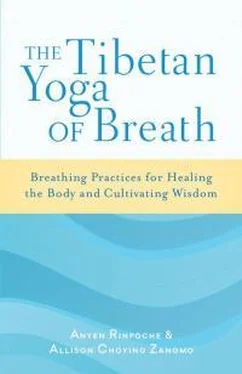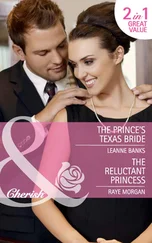Heart-wind has mental and emotional effects as well as physical ones. When we experience heart-wind, the region around the heart can feel agitated and fiery, especially inside the rib cage, making us feel impulsive, agitated, and short-tempered. The excessive energy of heart-wind can manifest in different ways. The agitation and volatility of heart-wind can lead to anxiety and restlessness. Or, if experienced over a long period of time, the chest and lungs can feel energetically heavy and may cause feelings of depression. The manifestation of heart-wind depends on the temperament and disposition of the person, as well as what the sensation of heart-wind feels like in the body.
Tibetan medicine sees heart-wind as the basis for all kinds of systemic imbalances. In terms of our bodily health, the medical tantras state that it is a source of pulmonary and cardiac disorders such as high blood pressure, heart disease, and heart attack.
According to our Tibetan tradition, heart-wind does not only result from habitual breathing patterns. Extreme emotional states, such as rage or despair, can produce heart-wind. These strong emotions can raise the level of wind energy in the upper part of the chest, and result in an immediate, severe physical and emotional reaction such as a heart attack or suicidal thoughts. Heart-wind is a condition that can be calmed through taking traditional Tibetan herbal medicine in conjunction with breath practices such as are taught in chapters 4 through 7 of this book, to correct the voluntary breathing pattern.
Wind Energy and the Emotions
We may think of the breath as something that is simply related to the exchange of oxygen and carbon dioxide and that keeps us alive. However, wind energy not only supports our ordinary bodily systems but it also quite literally drives our emotions. Thus, it is more than simply the experience of inhalation and exhalation. Wind energy is also the physical rush of energy that accompanies all of our feelings and sensations. If we examine the body and mind carefully, we notice a connection between the breath and how we feel. When the breath is calm and relaxed, we notice that the body’s energy is also calm, especially in the areas of the abdomen, lungs, and chest. As a result, the mind becomes clear and we feel relaxed and even-tempered. We feel that we can take things as they come and that we are capable of dealing with whatever life brings us.
On the other hand, when we are emotionally upset, we may notice that we breathe harder and faster, or that we are unable to inhale deeply and exhale fully. We notice a sense of pain, heaviness, or dullness in the abdomen and chest area, or even throughout the whole body, and that the mind is agitated by thoughts or overpowered by emotion. This overpowering energy manifests in all sorts of neurotic ways, such as depression, obsession, fear of intimacy, fear of trust, or feelings of grandiosity or inadequacy. Research has associated breathing patterns with specific emotional states—and it has also shown that we can influence our emotions by the way we breathe. 19In addition, Western medicine connects our psychological state with respiratory alkalosis. Respiratory alkalosis is associated with a lower pain threshold, 20with feelings of discomfort and agitation, 21and with imbalances such as anxiety and fatigue—all the result of less efficient oxygen delivery to the tissues and organs, including the brain. Some research states that dysfunctional breathing is as high as 5 to 11 percent in the general population, 30 percent in asthmatics, and up to 83 percent in those who suffer from anxiety. 22
When putting things in the context of wind energy, all of these emotions are simply an expression of imbalanced wind energy. However, even though all of these states of mind are a sign of unbalanced wind energy, they feel very different. And though the experiences of neurotic mind, energy, and emotions can appear and feel very different from one to the other, in every single case the mind can be thoroughly pacified and calmed through working with the breath.
Of course, change will not happen immediately. But generally speaking, over a long period of time, working with the breath is effective at cutting through all types of neurotic tendencies, because it brings the wind energy into balance. As the wind energy is brought into balance and becomes more stable, neurotic tendencies lessen and even begin to disappear.
In the Tibetan Buddhist tradition, we call this style of practice wind energy training, or the purification of wind energy. We call the broad tradition of purifying and working with the wind energy Yantra Yoga . Some traditions of Yantra Yoga also include complementary asanas, or physical poses and postures. While these asanas cannot be practiced by everyone, since every person has different physical capabilities, wind energy training can be practiced by anyone, at any moment, regardless of age or physical condition.
Much research has been done to show that working with the breath benefits not only our physical health but also our mental and emotional well-being. Tibetan Buddhism would also add to these the aspect of spiritual well-being. This research clearly shows that working with the breath balances the two components of the autonomic nervous system by enhancing parasympathetic nervous activity (enabling body and mind to relax) and decreasing sympathetic nervous activity (which causes the body to feel anxious or overly alert). It also improves respiratory and cardiovascular function, decreases the negative effects of stress and the production of stress hormones, and improves physical and mental health. 23
The Holistic Nature of the Elements
On a macro scale, the air element is vital to the life of all beings in the universe. On a human scale, air is also vital to the manifestation of the ordinary world around us. The atmosphere and the environment around us mirror the way that wind energy supports our own physical, emotional, and spiritual life.
Weather changes are related to the movements of warm and cold air masses called fronts. According to Western science, the tilt in the earth’s axis as it orbits the sun causes different parts of the world to receive more heat, which manifests as the four seasons. The movement of warm air brings spring to the world around us, causing the environment to bloom full of color. Rain and thunderstorms, hot and cold temperatures, the falling of snow, and extreme weather such as blizzards, tornadoes, and hurricanes are all disturbances of the air element.
And just as natural disasters occur when there is strong agitation in the air, so it is in the minds of humans. This is simply the law of nature. Imbalance brings the opportunity for great destruction. Wind energy has the same relationship to our mental and emotional energy as it does to the environment and atmosphere. When the wind energy is wild, agitated, or imbalanced, it manifests as physical illness in the body or as mental suffering, neurosis, or any other extreme state in the mind.
We also know that when the air element is harmonious, calm, and in balance, we tend to feel happy. When the sun is shining, the weather is warm, and the air is calm, life feels abundant, and we feel comfortable. Harmony in the elements makes it easy to feel good.
One additional piece of information will help us understand how truly powerful wind energy training is. From the point of view of Tibetan Buddhist philosophy, each of the elements itself is holistic. This means that the air element is not separate from the others; rather, it includes them. The air element contains aspects of water, earth, fire, and space, just as all of the other elements each contain an aspect of air. So when we work with any one of the five elements, we work with all of them. For example, the air element in the atmosphere has aspects of warmth or cold (fire), of moisture or dryness (water), of lightness or density (earth), and of expansiveness or contraction (space). Therefore, when there is an imbalance in the wind, all of the elements will fall out of balance. If the air element becomes dominant, then the aspects of water, earth, fire, and space will become weak or unstable. As a result, when one element is out of balance, an entire system becomes unstable, such as in the case of the atmosphere being disrupted by a hurricane or tornado. On the other hand, when each element is balanced, the whole system is balanced—just like a beautiful spring day. When we balance the wind energy, we bring stability to the systems of body and mind. And this is how wind energy training results in physical, emotional, and spiritual well-being.
Читать дальше












